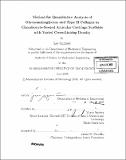| dc.contributor.advisor | Myron Spector. | en_US |
| dc.contributor.author | Squitieri, Lee (Lee S.) | en_US |
| dc.contributor.other | Massachusetts Institute of Technology. Dept. of Mechanical Engineering. | en_US |
| dc.date.accessioned | 2006-05-15T20:39:37Z | |
| dc.date.available | 2006-05-15T20:39:37Z | |
| dc.date.copyright | 2005 | en_US |
| dc.date.issued | 2005 | en_US |
| dc.identifier.uri | http://hdl.handle.net/1721.1/32924 | |
| dc.description | Thesis (S.B.)--Massachusetts Institute of Technology, Dept. of Mechanical Engineering, 2005. | en_US |
| dc.description | Includes bibliographical references (leaf 29). | en_US |
| dc.description.abstract | Articular cartilage tissue engineering is a useful tool to study and enhance the wound healing processes of articular cartilage in vivo. Current tissue engineering scaffolds for articular cartilage are produced by cross-linking type II collagen with glycosaminoglycans (GAG), creating pores in the resulting construct, and then seeding these pores with chondrocytes (articular cartilage producing cells). However, little information is known regarding the effect of cross-linking on the composition of the tissue that is produced by the chondrocytes, i.e. the relative quantity of GAG and type II collagen produced. In this study, I describe a method for the quantitative analysis of glycosaminoglycans in chondrocyte-seeded articular cartilage scaffolds with varied cross-linking density. Unlike other methods for determining GAG content, which digest the tissue sample (DMMB assay), my methodology accurately assesses the GAG ,content in stained histological tissue sections, therefore allowing the researcher to study tissue morphology. After identifying a parameter to quantify the intensity of red color in the tissue sections, the method was applied to the quantification of GAG distribution in samples of natural and engineered cartilage cultured for two weeks in vitro. | en_US |
| dc.description.abstract | (cont.) These values were then compared with biochemically determined values for validity. In conclusion, this study has demonstrated the utilization of image processing techniques to consistently produce quantitative values for the determination of GAG in Safranin-O stained histological tissue sections. Future work may expand and adapt this protocol for the quantification and spatial determination of other types of stains, such as the immunohistochemical staining procedure for type II collagen. | en_US |
| dc.description.statementofresponsibility | by Lee Squitieri. | en_US |
| dc.format.extent | 29 leaves | en_US |
| dc.format.extent | 1019520 bytes | |
| dc.format.extent | 1018273 bytes | |
| dc.format.mimetype | application/pdf | |
| dc.format.mimetype | application/pdf | |
| dc.language.iso | eng | en_US |
| dc.publisher | Massachusetts Institute of Technology | en_US |
| dc.rights | M.I.T. theses are protected by copyright. They may be viewed from this source for any purpose, but reproduction or distribution in any format is prohibited without written permission. See provided URL for inquiries about permission. | en_US |
| dc.rights.uri | http://dspace.mit.edu/handle/1721.1/7582 | |
| dc.subject | Mechanical Engineering. | en_US |
| dc.title | Method for quantitative analysis of glycosaminoglycans and type II collagen in chondrocyte-seeded articular cartilage scaffolds with varied cross-linking density | en_US |
| dc.type | Thesis | en_US |
| dc.description.degree | S.B. | en_US |
| dc.contributor.department | Massachusetts Institute of Technology. Department of Mechanical Engineering | |
| dc.identifier.oclc | 62764289 | en_US |
